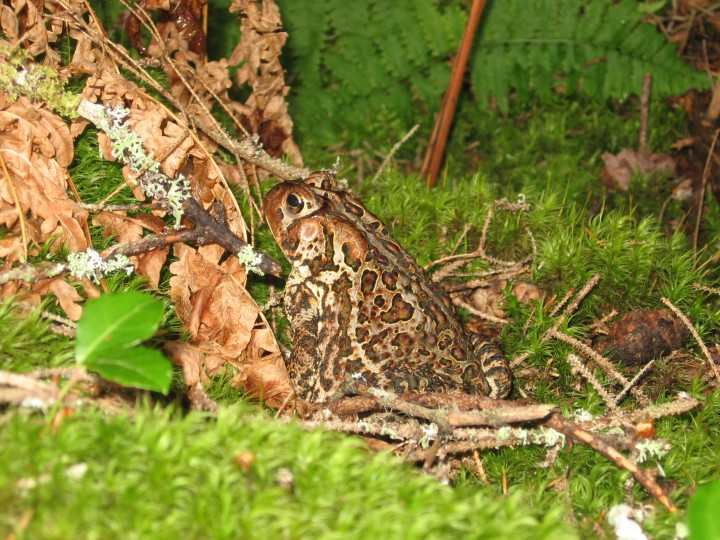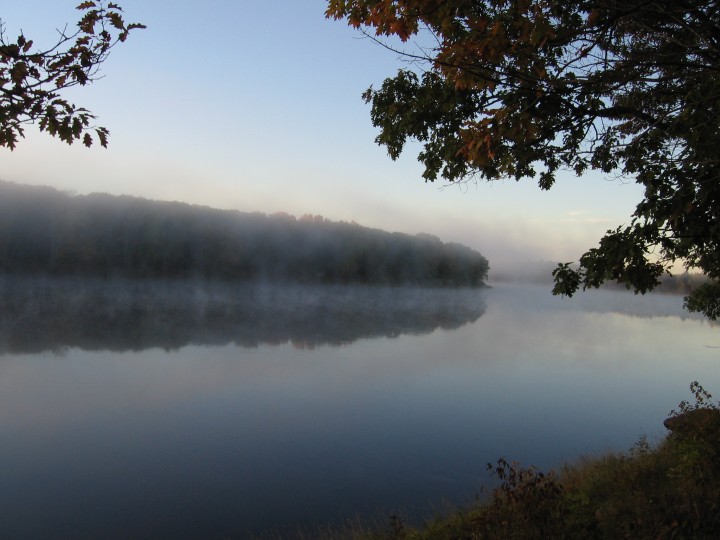Penobscot Experimental Forest, Bradley, Maine
Temperature: 70 °F Humidity: 96% Wind: 5 mph Cloudy with scattered showers.
From Dr. Ranson:
Well, we finally got some rain. It was only about ten minutes and not very intense, but it was rain. The rest of the day was quite overcast but dry. Considering that there has been a hurricane in the Atlantic and summer convection cells, with no rain falling on us, I think we’ve been doing really well. It’s like the song from Camelot, you know, about the rain never falling until after sundown. That’s what it’s been like here, so far.
The wet weather has brought out a little fauna. We saw a small snake, a pickerel frog or two and a toad. Paul thought he heard a woodcock. Five wild turkeys surprised us in the road. No one saw any spiders today but it was Kathleen’s day for slugs. She kept finding them everywhere.

This morning’s plot held a lot of medium to large size trees, with some dense understory here and there. The most unusual thing about that plot was that, somehow, when we walked out of those woods we were filthy. I hadn’t figured out how it happened. The trees didn’t look dirty and we didn’t do anything different. But we came out with this black stuff all over us, our hands, our clothes and even on our faces. I guess there must have been soil on the leaves and trees, so that as we pushed through them we got covered. I hadn’t ever experienced anything quite like this before. It’s fine, just kind of strange.
In the afternoon we went to a site that had been logged quite a bit. We found a lot of stumps of big trees and a lot of small trees, but few trees over 10 cm DBH. In one subplot, we found only one measurable tree. So we’re standing there with only a few measured trees and on paper it looks like we have zero biomass. Of course, that’s not true. There’s a good bit of biomass. We can see it everywhere. We’re standing right in the middle of it.
When we’re in this situation, we measure the few trees we can, then we count a sampling of the smaller trees. Our data sheet lets us quantify how many trees we have in the 0-2cm, 2-4 cm, 4-6 cm, 6-8 cm and 8-10 cm categories. We also assess their height. So even though we don’t measure the smaller trees, we’re in no way ignoring them. We can calculate a biomass measurement for this plot from our datasheets.
The lidar isn’t going to be ignoring them, either. They do have height and they really are there, so the instrument is going to give us a reading. We’ve flown our instruments over this area already, so we’ll be able to see just what our instruments do with these smaller trees. It will be an excellent opportunity to validate our data and to improve algorithms.

In the plot this afternoon, the few big trees we found were really tall for their DBH. We had some with DBH of 12-13 cm with a height of 10 meters, or about 33 feet. Even the smaller trees were tall. They are all competing fiercy, tying to grow tall very quickly to reach the light.
These trees are almost all quaking aspen, Populus tremuloides. It’s a very beautiful tree and one we haven’t seen a lot of here before today. They reproduce primarily by what is called a clonal reproductive strategy. They usually reproduce by sprouting from the root systems from existing trees. So all the shoots are genetically identical – they are clones. Aspen can and will grow from seeds but the seeds have such exacting requirements for germination that it doesn’t happen all that often.
Sprouting from roots allows the aspen to fill in a disturbed area very quickly. A mature root system can put out 400,000 to 1 million shoots in a year and the trees can grow a meter a year. When an area is disturbed, sunlight floods the aspen roots and sprouting begins almost immediately, while the seeds of other species are lying on the ground preparing to germinate. The aspen shoots and saplings will aggressively compete for light, creating stands that are very dense and very tall like this one. Because aspen requires full sun to live any sapling that becomes shaded will die. Eventually this will become a more open forest.
It’s interesting to note that the rapid growth of the aspen will quickly create some shade in an otherwise sunny area. There are seeds that require shaded conditions to germinate, so the intitial flush of monoclonal aspen will allow the growth of a more diverse forest. From the first disturbance, all the pieces fit together in a very complex way over time to ultimately create the diverse and open mature forests we’ve seen in Maine.
Right now, however, this area is dense and full of small trees, most of which we did not measure. It seems strange to walk away without those measurements, but it is simply not possible to measure every piece of vegetation, so we have to set limits. We know that 92% of the biomass of forests is found in trees over 10 cm DBH. It’s generally accepted that 92% is a good, accurate depiction of reality and that 8% is an acceptable margin of error. Balanced against the increased time, effort and cost that measuring smaller trees entails, scientists have agreed that 10 cm was a reasonable cut off point for measurements. So that’s what we do.
We believe the remote sensing is measuring trees that we do not, especially in areas like this afternoon’s plot. It’s great to be able to find an area to verify this,and to see how the remote sensing instruments will differ from the field measurements. We have gotten some tremendous data today. It was quite a long day but very satisfying.




thank you for educating me on quaking aspen growth.